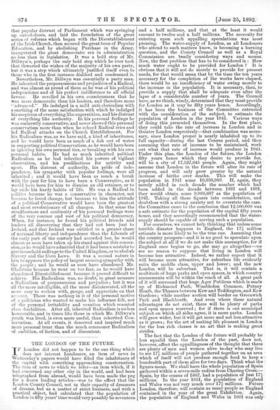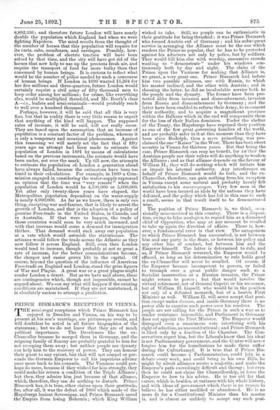THE LONDON OF THE FUTURE.
IF London did not happen to be the one thing which does not interest Londoners, an item of news in Wednesday's papers would have filled the inhabitants of the capital with something approaching consternation. The item of news to which we refer—an item which, if it had concerned any other city in the world, and had been telegraphed from abroad, would have been made the peg for a dozen leading articles—was to the effect that the London County Council, not in their capacity of dreamers of dreams, but as a matter of strict business, and with a practical object, had calculated that the population of London in fifty years' time would very possibly be seventeen and a half millions, and that at the least it would amount to twelve and a half millions. The necessity for entering upon such appalling speculations was most pressing. The water-supply of London, as all Londoners who attend to such matters know, is becoming a burning question, and the County Council as well as a Royal Commission are busily considering ways and means. Now, the first problem that has to be considered is : How much water ought to be provided for London ? It is obvious that it will not do merely to provide for present needs, for that would mean that by the time the ten years necessary for the completion of the works have elapsed, there would be an insufficiency of water owing merely to the increase in the population. It is necessary, then, to provide a supply that shall be adequate even after the lapse of a considerable number of years. The Council have, as we think, wisely, determined that they must provide for London as it may be fifty years hence. Accordingly, it has been the business of the Committee entrusted with the consideration of the subject, to estimate the population of London in the year 1941. Various ways of doing this presented themselves. In the first place, they could take the rate of increase in London and in Greater London respectively—that combination was neces- sary, since London proper is nearly inhabited up to its full capacity—during the last Census period, and then assuming that rate of increase to be maintained, work out what that rate of increase would produce in 1941. Under this plan, the London of the future, the London fifty years hence which they desire to provide for, will be a city of 17,527,645 people. Again, they might assume that London in the future will alter its rate of progress, and will only grow greater by the natural increase of births over deaths. This will make the population in 1941 some 10,836,989. If, again, they ' merely added in each decade the number which had been added in the decade between 1881 and 1891, they would obtain some 9,966,687 as the population of 1941. Taking all these figures into consideration, and doubtless with a strong anxiety not to overstate the case, the Committee came to the conclusion that 12,500,000 was a safe estimate for the population of the capital fifty years hence, and they accordingly recommended that the water- supply should be capable of serving such a population. For ourselves, we cannot help thinking that unless some terrible disaster happens to England, the 171 million estimate is more likely to be the true one. Assuming that the country prospers—and it is no good to speculate upon the subject at all if we do not make this assumption, for if England once begins to go, she may go altogether—we see no reason to suppose that living in London will become less attractive. Indeed, we rather expect that it will become more attractive, for suburban life evidently suits the middle class, upper and lower ; and the new London will be suburban. That is, it will contain a multitude of huge parks and open spaces, in which country amusements will be within the reach of all. A great part of it will surround that huge Ager Publicus which is made up of Richmond Park, Wimbledon Common, Putney Heath, the Thames between Kew and Teddington, and Kew Gardens ; while another section will border on Greenwich Park and Blackheath. And even where these natural advantages do not exist, there will be plenty of parks and open spaces reserved ; for if there is one municipal subject on which all sides agree, it is more parks. London will grow wider, but it will get more and not less attractive as it grows ; for the art of making life pleasant in London for the less rich classes is an art that is making great strides.
The fact that the London of the future will probably be less squalid than the London of the past, does not, however, affect the appallingness of the thought that there are plenty of men and women alive to-day who may live to see 171 millions of people gathered together on an area which of itself will not produce enough food to keep a hundredth part of them alive for two days. Think what the figures mean. We shall have the whole population of Spain gathered within a seven-mile radius from Charing Cross,— Spain, by the census of 1887, had a population of just ln millions. In the year 1851, the population of England and Wales was not very much over 171 millions. Future London, therefore, will contain as many people as England contained in the year of the great Exhibition. Again, the population of England and Wales in 1801 was only 8,892,536; and therefore future London will have nearly -double the population which England had when we were fighting Napoleon. The mind recoils from the thought of .the number of horses that this population will require for its carts, cabs, omnibuses, and carriages. Possibly, how- ever, the problem of electric traction will have been solved by that time, and the city will have got rid of the horses that now help to use up the precious fresh air, and require the transport of food far more bulky than that consumed by human beings. It is curious to reflect what _would be the number of police needed by such a concourse _ of human beings. If London in 1890 wanted 15,264 for her five millions and three-quarters, future London would 'certainly require a civil army of fifty thousand men to keep order among her millions ; for crime, like everything else, would be multiplied threefold, and Mr. Booth's class A—i.e., loafers and semi-criminals—would probably reach to well over a hundred thousand.
- Perhaps, however, it will be said that all this is very fine, but that in reality there is very little reason to expect -that anything of the kind will happen. The supposed rates of increase, it will be said, will not really occur. They are based upon the assumption that an increase of population is a constant factor of the problem, whereas it is only a temporary and occasional phenomenon. Against this reasoning we will merely set the fact that if fifty years ago an attempt had been made to estimate the population of London in 1891 by means of calculations based on the previous increments, the estimate would have been under, not over the mark. Up till now, the attempts to estimate the population of. London a generation ahead have always failed, because the estimators have been too timid in their calculations. For example, in 1869 a Com- mission engaged in considering the water-supply expressed an opinion that the time was " very remote " when the population of London would be 4,500,000 or 5,000,000. Yet after only twenty-three years have elapsed, the Metropolitan population dependent on the water-supply is nearly 6,000,000. As far as we know, there is only one thing, excepting war and famine, that is likely to arrest the growth of London, and that is the adoption of a policy of . genuine Free-trade in the United States, in Canada, and in. Australia. If that were to happen, the trade of those countries would soon be very much increased, and with that increase would come a demand for immigration _thither. That demand would suck away our population at a rate which would astonish the statisticians. The artisans would follow the trade across the Atlantic as they now follow it across England. Still, even then London would tend to increase, though probably at not so great a rate of increase, for the better communications become, the cheaper and easier grows life in the capital. Of course, beyond the question of the influence of American Free-trade on England and London, stand the grim figures of War and Plague. A great war or a great plague might render London a desert. But as we have said above, these are contingencies which, though not impossible, cannot be argued about. We can say what will happen if the existing conditions are maintained. If they are not maintained, it -is absolutely useless to attempt a prediction.



































 Previous page
Previous page